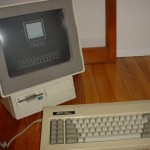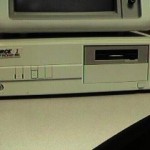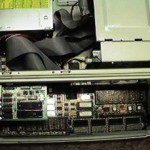I have always held an odd fascination for the Model 25. The same day I bought my Compaq 386s, I also happened upon a Model 25. I found it fascinating, as it was a PC that looked much like an early Macintosh. I had never seen a 25 before, and soon after began searching for one of my own. I have bid on several of them on eBay, but have always lost the bidding war. One day I spied one up for auction that was missing a few parts, but was otherwise salvagable. I won the auction for $9.00 plus shipping, and was soon happily beginning the search for repair parts. The day the Model 25 arrived I was not home. The UPS driver took it back to the his depot, and promptly lost it, so for the next week I was on the phone almost every day with the UPS depot supervisor. Finally, I got it back, but by this time it had gone from Oklahoma to Ohio to Oklahoma to Ohio again, and it was completely crushed. I sadly stripped it for what few parts were left undamaged, and tossed it in the trash.
The next day I was telling a co-worker about my woes, and he said that he knew where there were at least three of them he could get for free. Within four days I was the proud owner of three nearly perfect color Model 25’s. One I cleaned up to keep, the second I gave to a friend, and God knows what I will do with the third.
The Model 25 was introduced to the public in 1987. It features an Intel 8086 processor, 512K of memory, a 720K floppy drive, and most of them have no hard drive. Luckily, I managed to download the Starter Diskette off the internet, and I did get a low density disk with DOS 3.3 on it with the smashed 25. As it is, this computer doesn’t do a whole lot, so I am hoping to find a 20MB hard drive with the proper interface for it soon. I just inherited a full version of DOS 3.3 and a copy of the original Windows, and I’m planning to install them on the 25.





